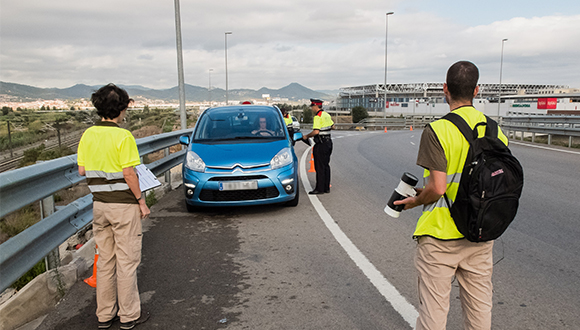Scientists and Catalonian National Police collaborate to catch tiger mosquito stowaways in private vehicles
The BaixLlobregat Mosquito Control Service is carrying out vehicle searches in coordination with the Mossos de Esquadra (Catalonian National Police) as part of the Atrapaeltigre.com project led by a team from CEAB-CSIC and CREAF. According to 2014 citizen data collected using the app Tigatrapp, this summer Spanish may have transported as many 800,000 tiger mosquitos in their vehicles.

How likely is it that a tiger mosquito may have travelled with us from Barcelona to Galicia over summer holidays? Under natural conditions this mosquito species is capable offlyinga distance of about 500 meters. Despite this, scientists know that some tiger mosquitos hide as stowaways in our cars, attracted by the dark interior. This way, in part due to chance and unknown to us, some mosquitos may travel hundreds of kilometers.
This is probably the mechanism enabling a badly flying insect to colonize the whole of Southern Europe.
For Frederic Bartumeus, the ICREA researcher coordinating the project Atrapaeltigre.com, understanding the frequency that the tiger mosquito hops a ride in our cars is crucial for estimating the impact of thismode of transport on the peninsular distribution of the species. “This information may also be key from the epidemiological standpoint since, as a vector of diseases, the greater its dispersal potential, the greater the risk to public health,” says Bartumeus from the Blanes Center for Advanced Studies of the CSIC (CEAB-CSIC). “Knowing if there are many tiger mosquitos travelling in cars right now can help us improve monitoring and control of the species, as well as improve predictive models which will tell us about its dispersal in the future,” he says.
The researchers take advantage of Mossos de Esquadra checkpoints to find stowaway mosquitos
This summer, over fivedays each week, certain CatalonianMossos de Esquadravehicle checkpoints go beyond the typical documentation checks: at their side, researchers from the BaixLlobregat Mosquito Control service will try to find any tiger mosquitos hiding inside the cars. Stopped at random, drivers within the most populated cities of this area of Catalonia collaboratewith the scientists by allowing them to carry out a vehicle inspection and responding to questions about any bites they may have received during their journey.
To catch any potential tiger mosquito specimens, the specialists are equipped with special entomological vacuum traps and carefully check the lower areas of the car cockpit where they usually hide.
The samplings are coordinated by Roger Eritja, biologist from the Service, and are part of a national research project led by the Atrapaeltigre.com team and funded by the Spanish Ministry of Economy and Competitiveness.
“We know from indirect evidences in the United States, Switzerland, and Italy that roadway traffic has an important role in the dispersal of the tiger mosquito. This is clear when looking at historical maps, because the newly affected areas are located around roadways. Despite this, no one has ever calculated the frequency that tiger mosquitos enter private cars. With the help of the Catalonia police we will be able to gain this important information,” says Roger Eritja.
This summer citizens may have mobilized more than 800,000 mosquitos
A year ago, the project AtrapaelTigre.com, coordinated by CEAB-CSIC and CREAF, was already asking users of its application if they had found tiger mosquitos in their cars.
With the Tigatrapp application, the project hopes that citizens will take photos of and alert about the presence of the tiger mosquitos in frequently visited places, also offering the possibility that the user adds the hashtag #coche (car in Spanish) in the associated report note for mosquitos discovered in cars.
A first estimation of the probability of transporting a tiger mosquito in a car is around 1%. Considering that Spanish Transit Directive reports 81.5 million car trips this summer, we can suspect that the Spanish will have inadvertently transported around 800,000 tiger mosquitos. According to Frederic, citizens can also contribute useful information forimproving the calculation of this figure. “The first results of the direct study of cars show that the figure will probably be lower. If in 2015 citizens participate in AtrapaelTigre.com and continue providing information about the presence of the tiger mosquito in their cars with the hashtag #coche we can see if the two approximations converge on the same number,” says the researcher.







